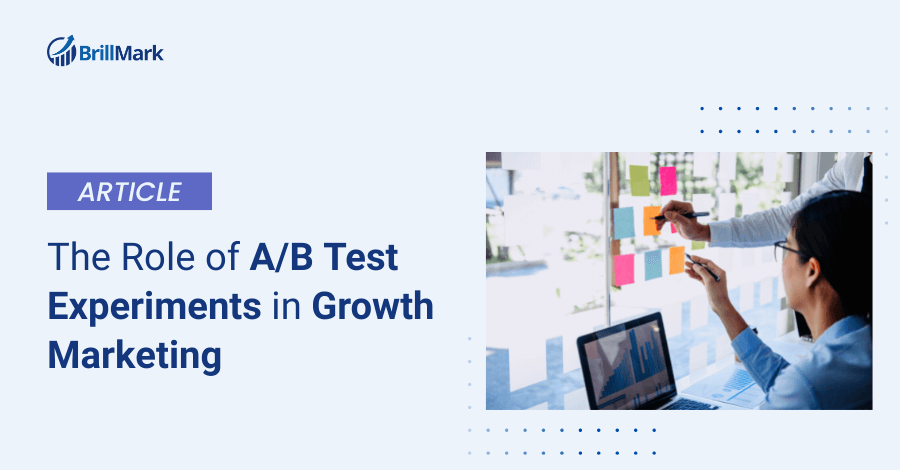Growth marketing is the term used to define the process of experimenting and improving a website to grow the customer base — all by just using data and metrics. Everyone wants to see their customer counts grow. To shine among the rest, you need to get a deep understanding of your target audience, serve them what they need, and make their experience on your site better and better.
When we say “understand your target audience,” we mean “look into your analytics.” Check audience behavior; know the sources of your leads, traffic, and clicks; and the list goes on. Now, once you know the areas which can use improvement, run an A/B test experiment for those areas. Find out users’ reactions to those improvements and if they seem good enough. Apply it on the site. Then that area is certainly going to perform better than the previous version, as it is optimized per users’ liking.
To explore more, there exist many kinds of experiments, such as A/B tests, multivariate tests, funnel testing, design experimentation, personalization, split-URL tests, and more. And to know what among these tests you need, you’ll have to know where you need it and why you need it.
To help you understand growth marketing from the point of view of our A/B test developers, below, we’ve written about the process, how we initiate it for our clients, and how it can help you.
Note: In one of our prior blog posts, we explained how big e-businesses such as Amazon, Netflix, and YouTube use analytical data to optimize their sites by utilizing A/B testing. Check out that post if you’d like more information on those examples.
Steps Toward Experimentation for Growth Marketing
- Identifying and Setting Up Goals
- Ideation and Hypothesis
- Experiment Building
- Quality Assurance
- Implementation and Analyzing
- Applying the winner on the site
Step 1. Identifying and Setting Up Goals
To find the direction for your experiments, analyze your existing data to find the areas which could use some optimization. Within your analytics, you can find out where you have the most traffic and which pages convert the most by observing screen recordings, heatmaps, analytics, and hosting site data. For example: You could optimize the navigation bar to reduce bounce rates after observing an exit rate after users click on it.
This will help categorize your audience into different criteria, which further helps you track goals while experimenting. That way, you can identify the areas which could use some alterations to perform better. For example, the web pages with the highest bounce rates could benefit from experiments to make them more engaging.
Goals are necessary so you have a motive behind the whole process. It could be lowering bounce rates, reaching a minimum conversion rate, hitting KPIs, or whatever suits the experiment the best per the analysis.
Step 2. Ideation and Hypothesis
After checking pages you finalized for experimentation, you’ll need to come up with ideas for the variations and what changes should be implemented. Conversion rate optimization is a great way to find ideas and additional elements specifically suited for your business and users. Your ideation and rough designs then could be mirrored in the next steps: experimentation.
The whole experimentation process is done to provide a better user experience, which eventually contributes to increasing the audience, conversions, and revenue. Those ideas could use a hypothesis to convey the motive behind the change. That will help the developers understand your perspective while moving on with the creative part.
Step 3. Experiment Building
The experiment ideas (along with hypotheses and goals) provide you with information about the targeting and A/B testing tools of your choice, but it may be necessary for A/B test developers to have access to set up the experiment. Experiment building is done per the requirements of the presented idea to be mirrored, where the design files will be perfectly converted into HTML/CSS. Other necessary skills, such as JavaScript, coding, UI and UX graphics, and more, are used to build a high-quality experiment. The developers ensure the experiments work well in all applicable devices and browsers.
Step 4. Quality Assurance
Once the development team is satisfied with their work, they send it for review to a quality assurance expert on A/B tests. The review is important to keep the experiment flicker, bug, and error free. If it doesn’t pass the review, the developer team reworks it and resolves the issues pointed out by the Q/A expert. It has to tick all the boxes of the Q/A checklist to ensure it will go live on the site without problems.
Step 5. Implementation and Analyzing
The test is implemented on the site per audience targeting. It’s only viewed by a specific set within your audience. Those who fall under the version’s bucket (the audience which fell in the variation’s bucket during traffic allocation) will be able to see it; others will see the original version only.
The performance of the tests has to be tracked until the experiment gains enough data for analysis. It takes some time to collect the sample size to evaluate the results.
The new experimental version has to complete all the designated goals in order to win and replace the original. If it fails to do so, more alterations could be made by using the existing data about the audience’s actions and response to it.
Step 6. Final Implementation of the Winning Version
Once the experiment is approved, the live version can be implemented on the site.
For a visual representation of this process in brief, have a look at this example: Experiment for the add to cart button.
Conclusion
This is what the experimentation process generally looks like, but it also depends on what in-house methods you might already want to use. The reasoning is to create an excellent user experience. Once started, you can always use the data from each new experiment to do follow-up experiments, even after checking the performance of the experimented page some months later. The approach here is to keep making your site better and grow your audience while doing so.
Growth marketing and growth hacking are data oriented, and experiments use the same data to provide a better user experience to the audience — all to grow your business. Be it revenue, traffic, sustainability, small goals, etc., find what works best for you to achieve that.
However, it’s not mandatory to choose growth marketing only; there are still many forms of marketing you can opt for. Exploring growth hacking and growth marketing will help you to confirm whether you really need them or not.
Above, we’ve explained the role of experiments in growth marketing. If you’re just getting started with A/B test development, this may be a new concept. We can help further introduce you to it — and help you take it in any desired direction — to help grow your business. Our A/B test developers are experienced in designing and implementing experiments. Let us know if you need assistance with that by filling out the form below.











